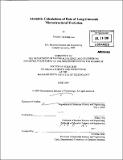| dc.contributor.advisor | Sidney Yip. | en_US |
| dc.contributor.author | Lau, Timothy Tin-Ming, 1984- | en_US |
| dc.contributor.other | Massachusetts Institute of Technology. Dept. of Materials Science and Engineering. | en_US |
| dc.date.accessioned | 2010-03-25T15:19:46Z | |
| dc.date.available | 2010-03-25T15:19:46Z | |
| dc.date.copyright | 2009 | en_US |
| dc.date.issued | 2009 | en_US |
| dc.identifier.uri | http://hdl.handle.net/1721.1/53242 | |
| dc.description | Thesis (Sc. D.)--Massachusetts Institute of Technology, Dept. of Materials Science and Engineering, 2009. | en_US |
| dc.description | Vita. Cataloged from PDF version of thesis. | en_US |
| dc.description | Includes bibliographical references (p. 99-111). | en_US |
| dc.description.abstract | The ability to investigate materials systems at the resolution of individual atoms makes computational simulations a powerful tool for the study of materials phenomena. However, microstructural evolution in complex materials is only meaningfully characterized in laboratory or industry applications by deformation rate and relevant rate coefficients, quantities that require sampling over a timescale too large for traditional atomistic methods to probe. New methods and techniques have to be developed in order to obtain useful information of rate from atomistic simulations. In this thesis, we explore a set of four problems, related to two long-timescale microstructural phenomena, creep and oxidation, and use a variety of atomistic methods appropriate to each problem to demonstrate the techniques of obtaining rate information. Creep due to vacancy-driven dislocation climb critically depends on the movement of the vacancies in the bulk towards dislocation cores, and for the first contribution of the thesis we investigate the influence of carbon solute atoms on vacancy diffusion pathways in bulk BCC Fe. Using these results, we draw explanations of the trends of the experimentally-observed rate of creep. It is well-known that vacancy energetics vary with distance from dislocation cores due to the dislocation strain field, but the effect this has on creep by the dislocation climb mechanism is not well understood. In the second contribution of the thesis, we present an investigation of the vacancy-dislocation interaction of BCC Fe. | en_US |
| dc.description.abstract | (cont.) By obtaining the details of the unit processes of vacancy migration around a dislocation core and formulating this information appropriately for numerical techniques based on transition-state theory, we enable the calculation of the dislocation climb rate with full atomistic detail. In the oxidation of metals, the transport of cations through the surface oxide film governs the overall material degradation. In the third contribution of the thesis, we present calculations of the energetics of defect formation and migration in nonstoichiometric Fe3604 spinel, which is closely related to the oxide film on Fe. We provide an explanation of experimental integral measurements of diffusion rate in a mechanistic, unit-process way. Creep of nanocrystalline materials is a new area of interest as fabrication techniques begin to impinge on this lengthscale; nonetheless, this phenomenon is not well understood and existing computational studies all involve unrealistic thermal or mechanical loading conditions. In the last contribution of the thesis, we present an investigation of the creep of Fe nanocrystals, employing a novel method of activating states to directly calculate a rate. We reach a rate regime that is inaccessible by traditional methods as well as identify some of the relevant unit processes in this type of creep. The rates of these slow dynamics phenomena are all investigated on the basis of their atomistic unit processes. However, there are differences in how information of the unit processes is obtained from atomistic calculations and in how the properties of these unit processes are subsequently used to understand the overall rate. | en_US |
| dc.description.abstract | (cont.) That different investigation approaches are needed is a direct result of the variation in the complexity of the microstructures, the number and predictability of atomic transition mechanisms, and the depth of existing experimental knowledge. These four studies therefore represent distinct, but complementary, challenges within the common theme of rate calculation. We conclude the thesis with an appraisal of the types of challenges encountered and with an evaluation of the approaches we took to the problems. | en_US |
| dc.description.statementofresponsibility | by Timothy Tin-Ming Lau. | en_US |
| dc.format.extent | 112 p. | en_US |
| dc.language.iso | eng | en_US |
| dc.publisher | Massachusetts Institute of Technology | en_US |
| dc.rights | M.I.T. theses are protected by
copyright. They may be viewed from this source for any purpose, but
reproduction or distribution in any format is prohibited without written
permission. See provided URL for inquiries about permission. | en_US |
| dc.rights.uri | http://dspace.mit.edu/handle/1721.1/7582 | en_US |
| dc.subject | Materials Science and Engineering. | en_US |
| dc.title | Atomistic calculations of rate of long-timescale microstructural evolution | en_US |
| dc.type | Thesis | en_US |
| dc.description.degree | Sc.D. | en_US |
| dc.contributor.department | Massachusetts Institute of Technology. Department of Materials Science and Engineering | |
| dc.identifier.oclc | 535849094 | en_US |
